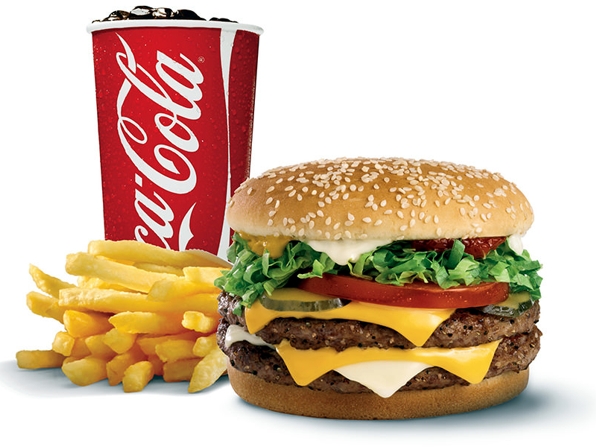A long term study by researchers at Boston University published earlier this year revealed that – in spite of adding some ‘healthy alternative’ menu items – fast food offerings at the ten largest U.S. chains have increased in Calories and Salt content consistently over the past 30 years…
 One meal with an entrée and side provides an average of 767 Calories
One meal with an entrée and side provides an average of 767 Calories
– close to 40 percent of a 2,000-calorie a day diet.
Researchers noted, in their preamble, that Fast Food dining is on the rise around the world, with major American chains making inroads in Asian and other markets over the past 10 years especially. And it’s not waning in popularity back home in North America, either.
About 37 percent of North American adults aged 20 or older consume fast foods on any given day, and that increases to 45 percent for adults aged 20-39. One meal with an entrée and side provides an average of 767 Calories – close to 40 percent of a 2,000-calorie a day diet. Add a high-Caloric (Sugary) beverage, and the amount increases to 45-50 percent of a person’s daily recommended Calorie intake.
What they did
Researchers compared changes over the 30-year period from 1986 to 2016 in the energy content, portion size, energy density, sodium, iron, and calcium of menu items in the entrées, sides and desserts offered by 10 of the top fast-food restaurants (according to sales). Data were collected using The Fast Food Guide, published in 1986 and 1991, and online sources in 2016.
What they found
The most significant findings were:
- Total number of entrées, desserts and sides increased by 226 percent, or 22.9 items per year.
- Calories in all three categories increased significantly, with the largest increases in desserts (62 Calories per decade), followed by entrees (30 Calories per decade). These increases were mainly due to the increase in portion size, which was statistically significant in entrées (13 grams per decade) and desserts (24 grams per decade) categories.
- Sodium content also increased significantly in all menu categories.
- At four of the 10 restaurants studied, information on calcium and iron content was available. Calcium increased significantly in entrées and desserts, while iron levels increased significantly in desserts. That’s actually a good thing. However, the investigators stress that there are better sources that do not come with high Calories and Sodium.
The takeaway
“Our study offers some insights on how fast food may be helping to fuel the continuing problem of obesity and related chronic conditions in the United States. Despite the vast number of choices offered at fast-food restaurants, some of which are healthier than others, the Calories, portion sizes, and Sodium content overall have worsened (increased) over time and remain high,” said lead investigator Dr. Megan A. McCrory. “We need to find better ways to help people consume fewer Calories and less Sodium at fast-food restaurants. The requirement that chain restaurants display Calories on their menus is a start. We would like to see more changes, such as restaurants offering smaller portions at a proportional prices.”
My take
First of all, most Fast Food joints do offer smaller portions of their most popular mains and sides, at proportional prices. McDonald’s classic Burgers range in size and price from the original Hamburger and Cheeseburger (250 and 300 Calories respectively) to the Big Mac (540 Calories). But specialty, heavily-dressed and ‘stacked’ Burgers, usually offered for a limited time only, often exceed the 750 Calorie mark. It’s up to the diner to keep track of their own Calorie, Salt and Fat intake.
However, I can easily see how increasing portion sizes and Salt content over the past three decades have paralleled the rises in obesity and diabetes. Regular Fast Food consumers – especially those in the crucial 20-39 age group – aren’t aware that the classic Burger they’re ordering today is larger and Saltier than it was back when they started including it in their daily routines. Once again, it’s up to us all to keep track of what we’re eating and adjust our intake accordingly to maintain safe, healthy levels of Calories, Fat, Salt and Sugar.
~ Maggie J.
